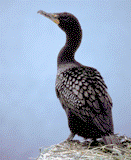United States Department of Agriculture, National Wildlife Research Center: Symposia

Symposium on Double-Crested Cormorants: Population Status and Management Issues in the Midwest
Date of this Version
December 1997
Abstract
Concurrent with the rapid growth of the Mississippi catfish industry during the 1980’s, there was evidence of similar growth of double-crested cormorant (Phalacrocorax auritus) populations wintering in the delta region of Mississippi. Observational and food habits studies indicate that this expansive industry, incorporating more than 100,000 acres of ponds, provides an enormous food base for overwintering populations estimated in recent years to exceed 50,000 birds. As much as 75 percent of the diet in certain roosting areas of the Mississippi delta consisted of catfish, and according to bioenergetic models cormorants can exploit as much as 940 metric tons of catfish per winter. Despite these data, there has been little attempt to demonstrate whether exploitation of this food base has increased body condition and possibly survival of wintering cormorants that return primarily to the Great Lakes region to breed. To examine this possible effect, we analyzed monthly changes in body masses of wintering cormorants collected in the delta region of Mississippi and compared premigratory body masses and fat deposition of Mississippi cormorants with those from areas without extensive aquaculture production. With the exception of adult females, all sex and age groups of cormorants collected in the delta during the winters of 1989– 90 and 1990–91 increased (P < 0.05) their body mass from November to April. Over all months, body masses of adult males and adult females were greater than that of subadults. Standardized by wing chord length, the premigratory body masses of Mississippi males and females differed (P < 0.0004) from premigratory males and females collected from Alabama in areas remote from catfish production. Premigratory fat deposition appeared to be responsible for the body mass increases, and omental fat mass was highly correlated (R = 0.721, P < 0.0001) with body mass and also differed (P = 0.0003) between Mississippi and Alabama birds. We hypothesize that the improved body condition of cormorants resulting from exploiting catfish has increased their survival and contributed to the population explosion of cormorants observed over the past decade. We suggest additional studies to substantiate our findings and to clarify the importance of southern aquaculture on improving body condition and survival of cormorants.

